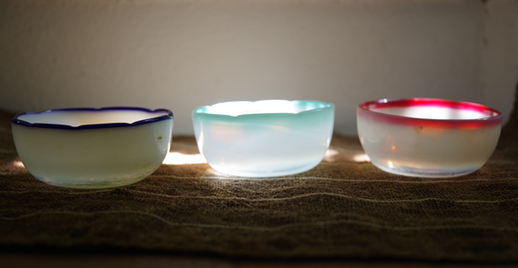「和」を知る・「和」を楽しむ・「和」を伝える日本のスペシャリストになろう!
白洲信哉=文筆家、日本伝統文化検定協会副会長

氷コップ(個人蔵)
梅雨入りし夏至を迎える頃、僕は食器棚の奥にしまっていた夏昼食の定番である素麺(そうめん)用の器、俗に「氷コップ」と呼ばれる大きめのガラス鉢を引っ張り出す。タイトルの「和ガラス」然(しか)り耳慣れない言葉だと思うが、どちらもメード・イン・ジャパンのガラス製品のことを指す。
わが国にガラスが伝わったのは弥生時代と考えられてはいるが、生活容器としてガラス製品が知られるようになるのは、16世紀中頃に、かのザビエル他宣教師などから伝えられた「びいどろ」や18世紀後半から19世紀中頃にかけてオランダ舶来の「ぎやまん」と呼んだ無色で良質なガラスの登場まで待つことになる。
前者の舶来品に触発され日本人が独自に開発したのが和製のびいどろで、素地の製法や意匠についても工夫し、18世紀初めには質も高くひとつの工芸品として完成域に達した型吹き食器が生まれる。後者に至っては渡来後間もなく、欧州のカットグラスを手本にしながらも素地や製法が全く異なる似て非なる日本製品が誕生したのである。
僕は普段から「用の美」に徹した生活を心がけてはいるが、江戸期和製びいどろはとても薄く脆(もろ)く、和製ぎやまんの代表で世界水準に照らしても遜色のないカットグラス「薩摩切子」はその品格と完成度が高すぎるが故に、もっぱら僕の愛用品は、明治後期から大正時代に出現した「氷菓器」、冒頭に記した氷コップである。
氷コップは宙吹きとプレスガラスに分かれるが、形や模様が多様な宙吹きが圧倒的に趣深く、名もない職人が西洋の模倣から離れ主に東京で製造された。溶けるような焦点の合わない乳白色が特徴で、ガラス質の気泡にもゆらゆら感があり、また手作りのため同型の物はない一点物、特に夏の強い太陽の光を通すとさまざまな色に千変万化、見ているだけで涼しくなってくる。色彩豊かな「日本の色」にバリエーションの豊富さと姿形の愛らしさから、昨今人気沸騰中、「和ガラス」の華と言っていい。
ちなみに「氷コップ」の「氷」とはかき氷のこと。かき氷の歴史は古く「枕草子」に記述があり、旧暦6月1日(本年6月25日)に宮中では「氷の節会」という行事が催されていた。一部の特権階級の嗜好(しこう)品であった氷が、明治2年横浜で初めてのかき氷屋が誕生し次第に普及する中で、それに似合ったアイテムが仕上がったのである。季節に合わせ食器を選ぶことで、コンビニのアイスでもこれに移し食せば、一味違う味に感じられるのは気のせいではないと思う。願わくは機械による均一の製品か手作りか、使う中で意識しつつ見極める眼を養ってほしい。
【English version】
Diverse Japan, Vol. 8: Japanese Glass
Shinya Shirasu = writer, vice-president of the Japanese Traditional Culture Certification Association

Ice cups (private collection).
Around the time the rainy season begins and the summer solstice approaches, I pull out a large glass bowl for somen noodles, a staple of summer lunches, and a glass bowl commonly called an “ice cup”, which I had stored away in the back of a cupboard. The title “Japanese glass” is probably an unfamiliar term, but both refer to made-in-Japan glassware.
Although it is thought that glass was introduced to Japan during the Yayoi period, it was not until the mid-16th century that glass products became known as everyday containers, with the introduction of “biidoro” from Xavier and other missionaries in the 16th century, and “giyaman” (colourless, high-quality glass) imported from the Netherlands in the late 18th to mid-19th centuries. The first two were introduced in the late 18th to mid-19th centuries.
Inspired by the former, the Japanese developed their own biidoro and devised the manufacturing process and design of the base material, producing high-quality, mould-blown tableware that reached the stage of perfection as a craft at the beginning of the 18th century. By the beginning of the 18th century, high-quality kata-blown tableware had reached the stage of perfection as a craft.
Although I usually try to live my life with a focus on the beauty of use, Japanese biidoro from the Edo period is very thin and brittle, and the cut glass Satsuma Kiriko, which is a representative of Japanese gyanban and comparable to world-class cut glass, has too much dignity and perfection, so that my favourite products are exclusively those from the late Meiji to Taisho periods, such as the The ice cups mentioned at the beginning of this article are called “ice cups”.
Ice cups were divided into space-blown and pressed glass, but space-blown ice cups, with their variety of shapes and patterns, were by far the most atmospheric, and were produced mainly in Tokyo by unknown craftsmen who had moved away from Western imitation. Characterised by a milky white colour with an unfocused melting effect, the glassy bubbles have a wavering effect, and because they are handmade, no two pieces are identical. The abundance of variation in the richly coloured Japanese colours and the loveliness of the shape have seen their popularity soar in recent years, and it is fair to say that they are the flower of “Japanese glass”.
Incidentally, the “ice” in “ice cups” refers to shaved ice. The history of shaved ice dates back as far as the Pillow Book, and on 1 June of the lunar calendar (25 June of this year), an event called the “ice festival” was held at court. Ice had been a luxury item for the privileged few, but with the first shaved ice shop opening in Yokohama in 1869 and its gradual spread, items were created to suit the occasion. By choosing tableware that matches the season, even ice cream from convenience stores tastes different if you eat it on this. Hopefully, you will develop an eye for whether the products are uniformly made by machine or handmade, and become aware of this as you use them.





